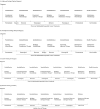An integrated framework for the study of exercise across the postdiagnosis cancer continuum
- PMID: 39376986
- PMCID: PMC11456400
- DOI: 10.3389/fonc.2024.1432899
An integrated framework for the study of exercise across the postdiagnosis cancer continuum
Abstract
Exercise plays many important roles across the entire cancer continuum that have been described in previous frameworks. These frameworks, however, have generally provided a simplified description of the roles of exercise postdiagnosis. The modern cancer treatment landscape has become complex and often consists of multiple lines of multimodal treatments combined concurrently and/or sequentially and delivered over many months or years. This complexity requires a more multifaceted and targeted approach to the study of exercise after a cancer diagnosis. Here, we propose a new integrated framework-Exercise Across the Postdiagnosis Cancer Continuum (EPiCC)-that highlights the distinct roles of exercise for disease treatment and supportive care from diagnosis until death. We also propose new terminology to clarify the distinct roles of exercise that emerge in the context of the modern cancer treatment landscape. The EPiCC Framework is structured around multiple sequential cancer treatments that highlight six distinct cancer treatment-related time periods for exercise-before treatments, during treatments, between treatments, immediately after successful treatments, during longer term survivorship after successful treatments, and during end of life after unsuccessful treatments. The EPiCC Framework proposes that the specific roles of exercise as a disease treatment and supportive care intervention will vary depending on its positioning within different cancer treatment combinations. As a cancer treatment, exercise may serve as a "priming therapy", primary therapy, neoadjuvant therapy, induction therapy, "bridging therapy", adjuvant therapy, consolidation therapy, maintenance therapy, and/or salvage therapy. As a supportive care intervention, exercise may serve as prehabilitation, intrahabilitation, interhabilitation, rehabilitation, "perihabilitation", health promotion/disease prevention, and/or palliation. To date, exercise has been studied during all of the cancer treatment-related time periods but only in relation to some cancer treatments and combinations. Moreover, fewer studies have examined exercise across multiple cancer treatment-related time periods within any cancer treatment combination. Future research is needed to study exercise as a disease treatment and supportive care intervention within and across the distinct cancer treatment-related time periods contained within different cancer treatment combinations. The aim of the EPiCC Framework is to stimulate a more targeted, integrated, and clinically-informed approach to the study of exercise after a cancer diagnosis.
Keywords: cancer treatments; combination therapy; exercise; multimodality therapy; physical activity; prehabilitation; rehabilitation.
Copyright © 2024 Courneya, McNeely, Booth and Friedenreich.
Conflict of interest statement
The authors declare that the research was conducted in the absence of any commercial or financial relationships that could be construed as a potential conflict of interest.
Figures




References
-
- Courneya K, Jones LW, Fairey AS, Campbell KL, Ladha AB, Friedenreich CM, et al. . Physical activity in cancer survivors: implications for recurrence and mortality. Cancer Ther. (2004) 2:1–12.
LinkOut - more resources
Full Text Sources
Research Materials

